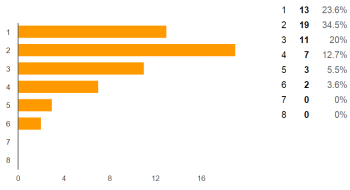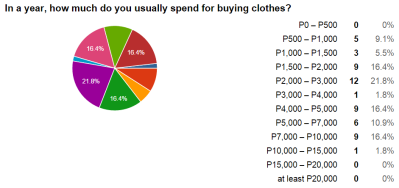Hi readers! For this post, I will share with you the desires of Filipino consumers as far as clothing is concerned. I observed the clothes of people around and I wanted to know more about the reasons that affect their purchasing decisions. So I asked them and tried to look into things from their own perspective.
I conducted a survey among the members of the UP community and their friends and relatives. I think the UP community is diverse and can be a good sample for this research. I managed to get 55 respondents who are aged 17 to 54, either studying or working, and mostly currently living in Metro Manila but whose hometowns are in Luzon, Visayas, and Mindanao. Moreover, the following demographics can also be drawn from the survey.
 Some of the respondents have tried shopping online but all of them prefer buying directly from physical stores. Sam Christopher Lim, the Senior Vice President for Marketing and Strategy of Francorp Philippines, noted in his article, How Pinoy retail brands are competing with global brands, that “according to the Euromonitor International Report, though online retailing of clothes is getting to be popular, buyers still want to go to stores and experience fashion for themselves. Department stores or boutiques are still the destination if one wants clothes, sportswear, and footwear.”
Some of the respondents have tried shopping online but all of them prefer buying directly from physical stores. Sam Christopher Lim, the Senior Vice President for Marketing and Strategy of Francorp Philippines, noted in his article, How Pinoy retail brands are competing with global brands, that “according to the Euromonitor International Report, though online retailing of clothes is getting to be popular, buyers still want to go to stores and experience fashion for themselves. Department stores or boutiques are still the destination if one wants clothes, sportswear, and footwear.”
Price, quality, fit, comfort, relevance, brand, design and style, and convenience and service are factors that consumers consider when buying clothes. I let the respondents rank these factors according to their preference and the following are the results:
I also asked the respondents other factors that they consider when buying clothes. Some of them answered that the versatility, functionality, or being multipurpose of a dress is also important—this is somehow part of the design and style. It is important for them for a piece of clothing to still look nice when mixed or matched with their other clothes. Some look for inspiration on fashion trends when buying clothes too. And others rely on other people’s opinion if a piece of clothing looks nice on them or base on their religion if a clothing would be modest for them.
Nevertheless, price was chosen by 37% of the respondents as their highest priority while fit and comfort were chosen as the highest priority of 32.7% and 25.5% of the respondents, respectively. Also, design and style was chosen by 23.64% of the respondents for the first priority and another 23.64% for the second priority. The quality got the second most number of votes for a rank with 34.55% of the respondents voting it as their second priority. On the other hand, relevance was voted highest for the seventh priority with 20% while brand and convenience and service landed on the least priority with 29.09% and 23.64%, respectively, ranking highest on the last spot.
As our Philippine economy rises, it is expected that the purchasing power of Filipinos will also rise. However, we have become smarter and price-conscious buyers. A Nielsen Global Survey of Consumer Confidence and Spending Intentions for the fourth quarter of 2014 shows that 62% of Philippine consumers spend less on new clothing while 35% of Filipinos spend on new clothing after putting spare cash into savings.
Furthermore, as stated in the online article, What Do Filipinos Spend their Money On?, a Consumer Financial Survey (CFS), conducted by the Bangko Sentral ng Pilipinas and released last year, reported that a typical Filipino family with a 20,000-peso average monthly income spends 5% or 1,000 pesos on clothing—the category with the least number of percentage, tied with miscellaneous. Thus, for an average Filipino family of four and with 12,000 pesos of clothing allowance, each member can spend 3,000 pesos for clothing in a year.
I asked the respondents how much they usually spend for a piece of clothing, how often they buy new clothes in a year, and how much they usually spend for buying clothes in a year. The following are the results:
Majority or 29.1% of the respondents usually spend 400 to 600 pesos for a piece of clothing and majority or 49.1% of them buy new clothes three to five times a year. From this, we can get the range 1,200 to 3,000 pesos (400 x 3 = 1,200; 600 x 5 = 3,000) which coincides with the majority of 21.8% of respondents who usually spend 2,000 to 3,000 pesos for buying clothes in a year. This also matches the inference I made based from the CFS report (i.e., each Filipino family member has 3,000 pesos clothing allowance yearly).
Moreover, a majority of 16.4% of respondents admitted that 70% of their clothes were bought because they need it while the remaining 30% was because they just want the clothes. 41.8% and 27.3% of the respondents wear medium and small-sized tops, respectively, while users of extra small and large-sized tops each amount to 10.9% of the sample. They were also asked the number of times they change clothes in a day and I found out that 65.5% of them change twice, 29.1% change once, and 5.5% change thrice. We can make an in depth research on how this can be related to the frequency of buying clothes of a Filipino consumer but this won’t be covered in the blog. We can also say something about how much time, effort, and patience a consumer invests in buying clothes based from the graph below.
According to the respondents, their top eight favorite clothing brands are Bench (32.72%), Uniqlo (32.72%), H&M (30.90%), Penshoppe (29.09%), Forever 21 (27.27%), Cotton On (12.72%), Artwork (12.72%), and Giordano (10.91%). However, 25.45% of them aren’t brand conscious—they simply just don’t mind the brands, prefer unbranded clothes, or buy from ukay-ukay.
There are a lot of conclusions that we can draw from this simple experiment. The relationships among the other demographics and some factors that affect the purchasing decisions of Filipino consumers might be available on the second part of this blog. Stay tuned!
P.S.: On the continuation of this blog, I will also share the top five pieces of clothing that the respondents have the most as well as the top three pieces of clothing that reflect their personal style. I will also try to explain their choice of clothes as they shared with me their activities during a regular weekday and a regular weekend and try to relate them with each other.
References:
80% of Filipino consumers curb spending in Q4 2014. (2015, January 26). Retrieved August 18, 2015, from http://www.rappler.com/business/personal-finance/81983-filipinos-curb-household-spending-nielsen
Lim, S. (2015, March 15). How Pinoy retail brands are competing with global brands. Retrieved August 18, 2015, from http://www.abs-cbnnews.com/business/03/15/15/how-pinoy-retail-brands-are-competing-global-brands
What do Filipinos Spend Their Money On? (2014, June 11). Retrieved August 18, 2015, from http://www.quickloan.com.ph/articles/filipinos-spend-money/














Hi there! I’m Joy Gamboa, currently a 2nd year Fashion Design and Marketing student at SoFA Design Insititute. I came across your page while searching for related topics for my thesis and I found this article to be quite helpful. Would you mind if I quoted some parts of your research for my paper? My topic is about the Filipinos’ level of acceptability for fashion knock-offs, btw. Hope to hear from you soon. God bless. 🙂
LikeLiked by 1 person
Hi Joy! Thank you for reading my blog. Sure, go ahead. Just be mindful though that I used descriptive statistics thus my conclusions only apply to the data at hand. Also, one of my professors shared this interesting article on fashion knockoffs which you might also find useful: http://style.time.com/2012/09/10/the-knockoff-economy-how-copying-hurts-and-helps-fashion/. I look forward to reading your thesis. God bless and be a blessing. 🙂
LikeLike
Such a help in our case study! Thank you! :*
LikeLike
You’re welcome, Joash! I’m glad this helps. 🙂
LikeLike